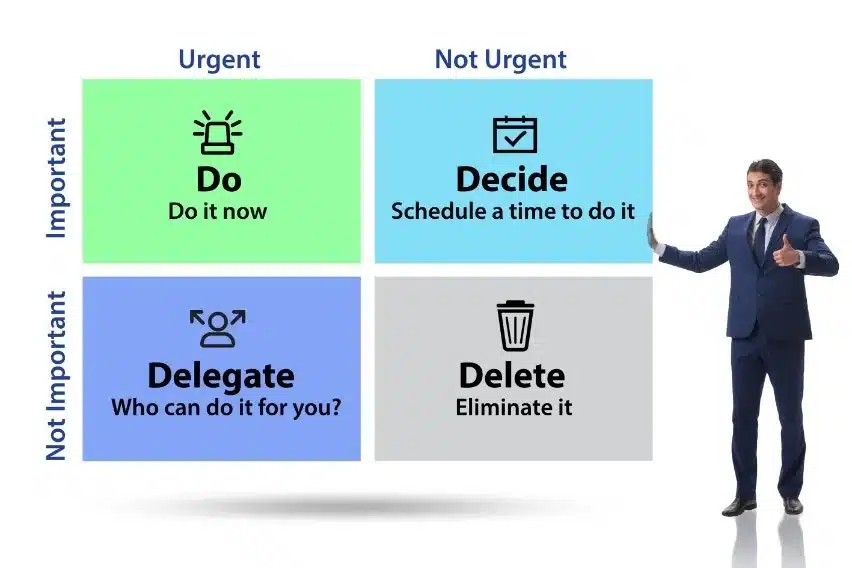Time is a precious resource, especially for business owners juggling various responsibilities and tasks. The Time Management Matrix, popularised by productivity expert Stephen Covey, offers a structured approach to prioritise and manage your time effectively. In this blog post, we’ll explore the Time Management Matrix and discuss how business owners can implement it into their daily routines to enhance productivity and achieve their goals.
Understanding the Time Management Matrix
The Time Management Matrix categorises tasks into four quadrants based on their urgency and importance:
- Quadrant I: Urgent and Important
- Quadrant II: Not Urgent but Important
- Quadrant III: Urgent but Not Important
- Quadrant IV: Not Urgent and Not Important
Let’s delve into each quadrant and understand how business owners can tackle their tasks within these categories.
Quadrant I: Urgent and Important
Tasks in this quadrant are both urgent and important, demanding immediate attention. They often involve dealing with crises, emergencies, and deadlines. Business owners must address these tasks promptly to prevent problems from escalating. However, spending too much time in this quadrant can lead to burnout.
Tips for Quadrant I:
– Prioritise tasks based on their actual urgency.
– Develop crisis management skills.
– Use effective communication to delegate responsibilities when necessary.
– Prevent crises by planning and allocating resources wisely.
Quadrant II: Not Urgent but Important
Quadrant II tasks are the key to long-term success and personal development. They include activities such as strategic planning, relationship building, skill development, and goal setting. Business owners who invest more time in this quadrant can reduce the number of tasks that shift into Quadrant I.
Tips for Quadrant II:
– Schedule regular blocks of time for Quadrant II tasks.
– Identify your long-term goals and create a plan to achieve them.
– Delegate tasks that others can handle to free up your time.
– Say no to activities that don’t align with your long-term goals.
Quadrant III: Urgent but Not Important
Tasks in this quadrant may seem pressing, but they often don’t contribute significantly to your long-term goals. They can include interruptions, meetings, or minor issues that can be delegated. Business owners should aim to minimise time spent in this quadrant to create space for Quadrant II activities.
Tips for Quadrant III:
– Assess the true importance of tasks before addressing them.
– Use time management techniques like time blocking to limit distractions.
– Delegate tasks that others can handle without your direct involvement.
– Politely decline or reschedule meetings that aren’t crucial.
Quadrant IV: Not Urgent and Not Important
Quadrant IV is the realm of time-wasting activities and distractions. These tasks provide little to no value and can drain your productivity. Business owners should aim to eliminate or minimise Quadrant IV tasks to maximise their efficiency.
Tips for Quadrant IV:
– Identify time-wasting activities and limit or eliminate them.
– Use technology wisely; don’t fall into the trap of mindless scrolling or excessive social media use.
– Set boundaries and allocate specific time for relaxation and leisure.
– Focus on activities that align with your goals and values.

Implementing the Time Management Matrix
To implement the Time Management Matrix into your daily routine as a business owner, follow these steps:
- **Task Identification**: Start by identifying your daily tasks and categorise them into the four quadrants. Be honest and objective about each task’s urgency and importance.
- **Priority Setting**: Allocate your time and attention according to the quadrants. Prioritise Quadrant II tasks, as they are the foundation of long-term success. Dedicate specific blocks of time to Quadrant I tasks but aim to reduce them through proactive planning.
- **Delegate and Eliminate**: Delegate tasks in Quadrant III whenever possible, freeing up your time for more important matters. Eliminate or minimise Quadrant IV activities that don’t contribute to your goals.
- **Effective Planning**: Develop a daily or weekly schedule that reflects your priorities. Allocate time for Quadrant II activities and use time-blocking techniques to stay on track.
- **Adapt and Review**: Continuously assess and adjust your time management approach. As circumstances change, your priorities may shift, so be flexible in your planning.
The Time Management Matrix is a powerful tool that can transform how business owners manage their time. By prioritising tasks based on urgency and importance, you can increase productivity, reduce stress, and achieve long-term success. Remember that effective time management is an ongoing process, so regularly review and adjust your strategies to align with your evolving goals and priorities. Mastering the Time Management Matrix is not just about managing your time; it’s about taking control of your life and achieving your business objectives.
